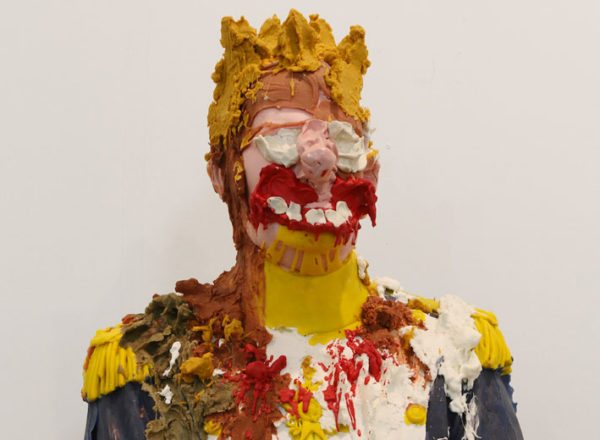


Jamie Fitzpatrick
Born in 1985, Jamie Fitzpatrick lives and works in London.
Graduated in 2015 from the Royal College of Art, London.
Represented by the VITRINE Gallery (London, Basel).
Untitled (Bust 7), 2016
Wax, scrim and polyurethane foam
78 × 56 × 39 cm
Unique piece
Work acquired in 2016
 The sculpted bust represents a dignitary wearing military-style clothing, such as a frock coat with epaulettes. Traces of coloured materials, badly applied, dirty his features (the nose, the teeth), making his appearance rather ridiculous. The treatment applied by the artist thereby transforms the figure into a grotesque representation, a caricature. The classical sculptural format, intended for memorial and celebratory functions, is severely criticized here. A ‘generic’ character is singled out and becomes a kind of clown. Jamie Fitzpatrick subverts a figure of masculine authority by ‘dirtying’ his appearance with a large amount of an organic substance. The traces of the artist’s gestures in the wax are deliberately outrageous and provide the work with a performative dimension, reminiscent, for example, of the work of American artist, Paul McCarthy.
The sculpted bust represents a dignitary wearing military-style clothing, such as a frock coat with epaulettes. Traces of coloured materials, badly applied, dirty his features (the nose, the teeth), making his appearance rather ridiculous. The treatment applied by the artist thereby transforms the figure into a grotesque representation, a caricature. The classical sculptural format, intended for memorial and celebratory functions, is severely criticized here. A ‘generic’ character is singled out and becomes a kind of clown. Jamie Fitzpatrick subverts a figure of masculine authority by ‘dirtying’ his appearance with a large amount of an organic substance. The traces of the artist’s gestures in the wax are deliberately outrageous and provide the work with a performative dimension, reminiscent, for example, of the work of American artist, Paul McCarthy.
The use of wax as a material refers to the history of sculptural techniques (lost-wax casting is a crucial step in the production of bronze pieces). It also evokes the popular tradition of wax figures of celebrities, which can be admired in museums like the Musée Grévin in Paris or Madame Tussaud’s in London. It is above all a material characterized by its instability and fragility. It threatens to evolve in the heat, becoming prey to the deformations that could degrade the figure.
In his sculptures, Jamie Fitzpatrick plays with the signs of power: statues, flags, pedestals, fountains, etc. For the artist, the place of these ‘models’ in the city and in the world, and the value conferred upon them by society, undermines our capacity, as individuals, to affirm our own unique identity.
Jamie Fitzpatrick demonstrates a certain penchant for theatricality, animating some of his pieces by means of mechanisms or by developing performances around them. These are structured around textual elements that come, to some extent, to provide a narrative dimension to the artist’s sculpted figures. A play, written by Fitzpatrick for example, was at the origin of his exhibition (loudly) chomp, chomp, chomp at the VITRINE Gallery (London, 2016). Recounting the epic adventures of a horse freed from the authority of its master, the play steers itself towards the theatre of the absurd, similar to that of Samuel Beckett.
Other figures who have influenced the artist’s work include contemporary sculptors Urs Ficher and Phyllida Barlow.